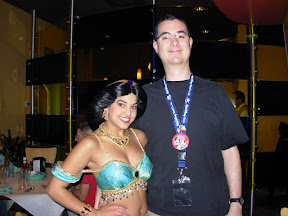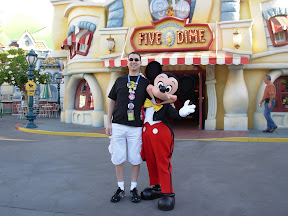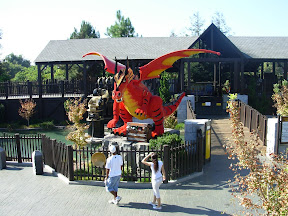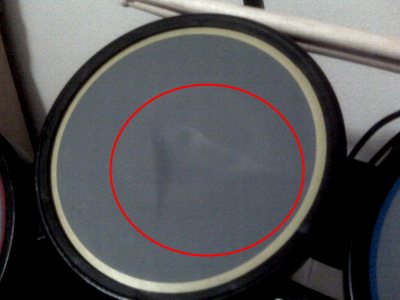For our second anniversary, Jenn and I packed up for a week and headed
down to sunny southern California to visit Disneyland and Legoland.
We flew down on October 14th and were hoping to get there in reasonable
time, but we had some fairly serious delays due to mechanical troubles
on the plane, so we spent most of the day stuck in the airport. Luckily,
we planned a “travel day” on either side of the actual vacation, so this
didn’t hinder us too badly.
The 15th through 17th we toured through Disneyland and Disney’s
California Adventure. It’d been years since either Jenn or I had been to
Disneyland and neither of us had been to California Adventure, so it was
really fun to see not only the stuff we were familiar with, but the new
rides and exhibits.

From Disneyland and Legoland
The 15th was primarily Disneyland. We stayed at the Disneyland Hotel, so
we took the monorail into the park first thing in the morning and while
everyone else was working front-to-back on the park, we worked
back-to-front. The first rides we did were the Mad Hatter’s Tea Party
and the Alice in Wonderland rides because Alice is, by far, my favorite
Disney character. Jenn wasn’t expecting much from the tea cups, but
Ireally cranked that thing around and we both left pretty dizzy. (A
kid coming on the ride after us literally ran to get our cup because “it
was the fastest one out there.” Heh.)
We continued on through Fantasyland and then went through into
Tomorrowland to enjoy some classic Star Tours action. After
Tomorrowland, we hit Adventureland, stopping in at the Jungle Cruise and
Enchanted Tiki Room, then through to see the Pirates of the Caribbean
(which has been updated to match the movie). We came back to ride the
new Indiana Jones ride and, while it was fun, we ended up having to ride
twice because the first time we rode, it broke down and we got stuck on
it (with the lights on and everything) for quite some time. We finished
off that first day watching the characters parade down Main Street, USA.

From Disneyland and Legoland
The 16th we started the morning with a character breakfast at Goofy’s
Kitchen, an all-you-can-eat buffet of just about anything you’d ever
want to eat. Princess Jasmine and Princess Aurora were there, as was
Goofy, Chip and Dale, Pluto, and Baloo. It sounds silly, but it was
actually very fun (and great food).

From Disneyland and Legoland
Following breakfast, we spent the day going through California
Adventure. California Adventure is less about the Disney cartoons and
more about celebrating the nostalgia of California history. While
there’s definitely some kid stuff here, I think it’s more adult-oriented
because smaller kids aren’t going to know what stuff like the California
Zephyr are.
We saw the Muppet Vision 3D movie, rode the taxi through Monstropolis
(from Monsters, Inc.), checked out the various Bug’s Life things,
and then wandered around on the boardwalk enjoying the rides and the
food. We finished off the day in California Adventure watching the Pixar
Play parade - a parade of Pixar movie characters.
Since California Adventure closed relatively early, we sauntered back
over to Disneyland to see the Haunted Mansion (now done up in Nightmare
Before Christmas style, and particularly so since it’s Halloween time)
and ride Splash Mountain. Let me tell you - you can get into Splash
Mountain easier later at night, but you really get soaked down and it
doesn’t dry up too well. Jenn and I walked the park soaking for quite
some time after that.

From Disneyland and Legoland
The 17th was dedicated to picking up rides and areas of the park we
didn’t get a chance to see. We started the day in Disneyland and enjoyed
the morning ceremonies in Toontown, getting our pictures with Mickey and
seeing other characters as well. After that we went back to Fantasyland
and took a cruise around Storybook land, seeing miniaturized versions of
significant storybook locations. We started getting tired after that so
we headed over to Tom Sawyer’s island and, after that, rode the Mark
Twain riverboat.
The day was pretty hot, and we were worn out, so we took a breather back
at the hotel for a bit before returrning to the park and riding the
California Screamin’ roller coaster in California Adventure, then
finishing out the day watching an amazing fireworks display over
Cinderella’s Castle in Disneyland.
The 18th we checked out early from the hotel and drove the hour or so
south from Anaheim into Carlsbad to see Legoland. Our hotel, the
Sheraton Carlsbad Resort and Spa, had a private entrance to the park, so
we headed right into the park without having to wait in line at the
beginning.
The phrase of the day was, “Hey, check out that <insert noun> made out
of Lego!” If you’ve ever seen a Lego show, or been to a Lego store and
seen some impressive models, Legoland puts all of that to shame.
Particularly the “Miniland” section, with full city replicas of
well-known US locations. It’s spectacular from a Lego perspective… but
the rides and attractions are definitely geared toward the younger (3 -
13) set. There’s really only one ride there for the older crowd: The
“Knight’s Challenge,” which is basically a robot arm from a car
manufacturing plant that someone welded some chairs to. You get in the
chair and it thrashes the living crap out of you. An awesome ride, to be
sure, and proves that it doesn’t need to have rails to be a good ride.
Another thing we noticed: Lego really hasn’t taken advantage of all of
the merchandising opportunities it could. There were only like five or
six different shirt styles that said anything about “Legoland” on them;
everything else, including the Lego sets, were all things you could get
at a Lego store or on their web site. There were a lot of things I
wanted that simply didn’t exist. Here’s hoping they figure that one out.

From Disneyland and Legoland
Since we finished out Legoland in a day, we took the 19th to sleep in
and rest our feet. Grabbed some breakfast at IHOP, drove down to see the
Hotel del Coronado, and basically were lazy, which was nice.
The 20th saw us checking out from the hotel in Carlsbad and driving back
to LAX to return the rental car and grab our plane home. Again, due to
misjudged timings and such, we spent most of the day traveling.
All in all, it was a great trip. I really do love Disneyland and it was
great to be a kid again. It’s sort of like going to Las Vegas (which I
also love) but with less sin. I will definitely have to find another
opportunity to go, or maybe hit Disney World in Florida so i can see
Epcot. I probably will wait a while before going back to Legoland, to
see if they do some renovations to address the older set or add some new
models. Good times.





